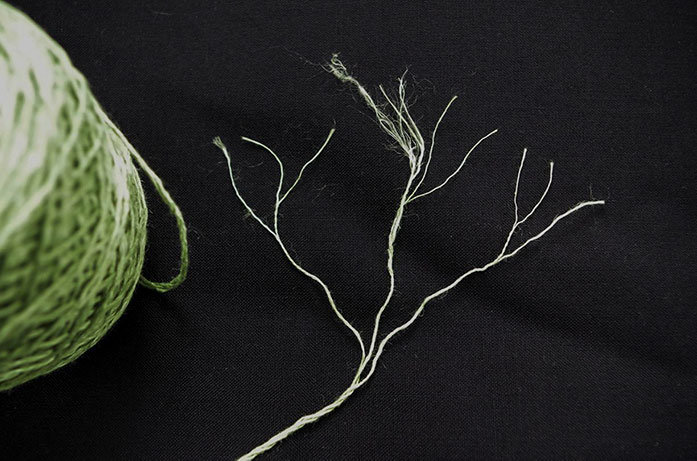In my quest to find the right two yarns to combine for the sweater I wanted to design for spring or fall evenings, I finally came across Lina by Fibra Natura. Yesterday I reviewed Whisper Lace, also by Fibra Natura, the lace-weight wool and silk blend, but today I want to explore the qualities of Lina’s amazing linen-cotton blend.

9 of the 12 colors of Lina available shown together highlight how well-chosen the color-range actually is. Any color in the collection goes well with the others.
This yarn is listed as sport weight, but when I knit with it on size 5US [3.75mm] needles, I got more of a DK weight stitch count of 22 or 21 stitches per 4″. Each hank is 100g and has a generous 252yds. I chose the Fern green color because it was a close match to the Reeds colorway I chose in Whisper Lace.

It is characteristic of plant-based fiber yarns to be comprised of many individual plies.
I like to really get to know the yarns I knit with. At first glance, Fibra Natura Lina looks a bit loosely spun. There’s a lot of separation between the larger plies and this gives the yarn its lightness of being and helps a lot with its drape. However, upon untwisting the plies, I discovered that there are 3 main plies that are spun loosely around each other, but each one of those strands is comprised of 3 even more tightly spun plies. The middle strand in the photo shows that one of the plies is loosely spun and has 2 binding plies that keep the looser fibers contained, but still relaxed.
The architecture of this yarn is definitely responsible for its strength, drape, and depth of color.

Lina is a versatile yarn. Change the needles size and you can get a range of gauges between 24 sts per inch to 20. The fabric has drape in every case.
I swatched with Lina on its own first to see what it behaved like at a tighter gauge. I really found that the swatch had a lot of drape and even some elasticity, which is unusual for a plant-fiber based yarn.

Row gauge is more accurate after wet-blocking. Read why below.
Row gauge is a little tricky to measure prior to blocking because the stitches like to separate from each other where they were sitting on the needles. But once wet blocked and pulled vertically and allowed to spring back, the stockinette fabric was more balanced and the gauge more accurate. I do this when I knit with linen or cotton because I want to imitate the effect gravity seems to have on plant-based yarn.
The other stitch patterns at the bottom and top of the swatch were an attempt at killing two birds with one stone. I wanted to see if these textured stitches suited my design idea. But they didn’t. So they just serve as lovely frames for my stockinette rows.

All the swatches done, I’m ready to design the sweater I’ll share with you tomorrow and Friday.
Tomorrow I’ll introduce you to my newest design blending Whisper Lace, a wool-silk lace-weight yarn and Lina, a linen-cotton sport-weight blend. Together they’ll behave like a worsted weight yarn.
In the meantime, there are some free designs that accompany Fibra Natura Lina and I’d like to introduce them to you now so that you have more than one project you can line up in your queue.

Fern and Amaranth, these two rich colors of Lina by Fibra Natura are used together in a lacy long scarfarita called Strawberry & Kiwi.
PDF of the free pattern for Strawberry & Kiwi Scarfarita

This scarf is knit with an all-over lace pattern that works up on the bias. It’s a quick, fun knit for a classy accessory
PDF of the free pattern for Ravine Tee-shirt

You can just see the drape in the photo of this tee-shirt knit with the Citrus and Mineral colors of Lina by Fibra Natura.
PDF of free shawlette pattern using Lavendula, Potting Soil for the body and Crocus for the edging.

Using an easy-to-execute Dip Stitch, you can knit this lovely shawlette that will drape over your shoulders on a fall evening.
